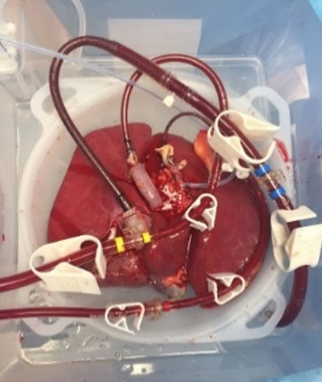
A new multi-center clinical trial has shown that ex vivo normothermic machine perfusion is safe and effective for liver transplants. Abdominal transplant surgeon Andrew S. Barbas, MD, performed the liver perfusions for the Duke cases in a randomized study that compared static cold storage (SCS) to normothermic machine perfusion (NMP) in nearly 400 liver transplants across 15 sites in the U.S. Duke abdominal transplant surgeon Stuart J. Knechtle, MD, was the principal investigator for the national study.
The study found no significant difference in early allograft dysfunction between the two storage conditions overall. However, subgroup analysis demonstrated that higher risk livers, such as livers donated after circulatory death (DCD) and those in the highest quartile of donor risk, performed significantly better with NMP.
NMP cases experienced a lower incidence of acute hypotension at organ reperfusion, also called post-reperfusion syndrome. The Duke patients in the study also showed a lower rate of intraoperative complications and better outcomes including lower peak aspartate aminotransferase (AST) within seven days.
Benefits of NMP
The perfusion device warms the organ and circulates blood, oxygen, medications, and nutrients to preserve it under physiologic conditions and allow for assessment. Duke began using NMP for liver transplants in 2017 and now regularly uses both of the FDA-approved devices for NMP in livers.
NMP preserves organs for longer, meaning Duke can accept livers from farther away, increasing the donor pool. “We’ve transplanted donor livers from as far away as Saskatchewan, Canada, and Puerto Rico,” Barbas says. “With the increased preservation time afforded by NMP, we can convert most transplants to daytime operations rather than trying to rush in the middle of the night.” This not only avails patients of the advantages of well-rested surgeons but also enables families to come for support more easily. Additionally, the increased preservation time allows organs to be preserved safely for longer procedures, such as a double organ transplant.
NMP has also helped to increase the effective use of higher risk donors, including DCD and donors over the age of 60 or with fatty infiltration of the liver. “We now use NMP for all our transplants for high-risk donors,” Barbas says. “The technology has allowed us to use donors from all those categories much more safely than before. It reduces the time on ice, which we know is especially injurious for marginal grafts.”
“NMP has changed how we do liver transplants,” Barbas says.
To refer a patient, see our Solid Organ Transplant Referral Forms or call 919-668-4755.
The Duke liver transplant program:
- gets patients transplanted faster: Duke liver transplant patients’ median wait time was 76 days, compared with 216 days’ wait nationally (SRTR January 2024 data).
- performs living donor liver transplants as well as deceased donor transplants.
- accepts patients with high risk, serious medical problems, and other complications including multiple organ transplants.
- is one of the few transplant sites in the U.S. to offer living- and deceased-donor transplants for HIV-positive patients.

